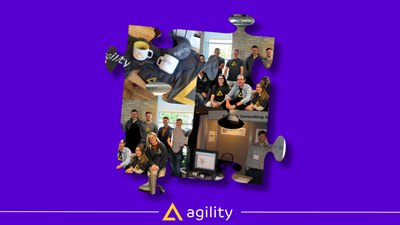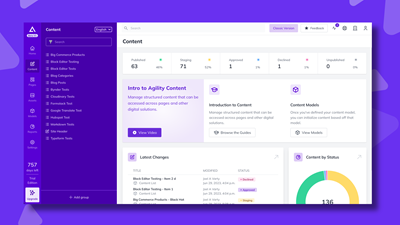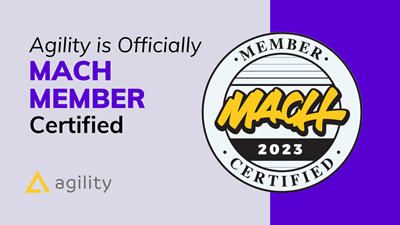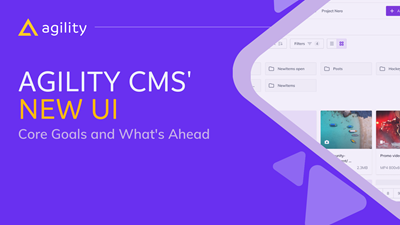Agility CMS Throughout the Years
What makes Agility CMS the oldest, newest headless CMS in the market.


Each year, more and more users consume web content on platforms other than computers. Mobile, IoT devices, gaming consoles, and smartwatches are now becoming the norm, and monolithic CMSs simply cannot keep up with the changing trends. This has created the need for a paradigm shift in how enterprises and brands deliver content to its users.
Around 2015, the term ‘headless CMS’ made its breakthrough worldwide.
The breakthrough of the headless CMS shouldn’t come as a surprise. The ability to send content to different channels from a central database is a must for companies with omnichannel customer journeys. Also, the separation of content and presentation helps teams develop new ideas for how to improve their customer experience across channels.
At Agility CMS, we see going headless as the next logical step that will lead us --and you-- to a better content management future. With the headless approach, content structure and architecture become more flexible. Also, since the content is treated as structured data, editors can work in sync to deliver better digital experiences.
In our case, we got an early start in the headless ecosystem, which has placed us in a unique position to offer our users value, experience, and innovation. In this article, we go deeper into the history of Agility CMS and what makes us the oldest yet newest headless CMS in the market.
The History of Agility CMS
Ten years ago, the mobile channel was the new kid on the block, disrupting content delivery. Nowadays, disruptions are happening much more quickly, with new devices and channels appearing every year, changing the playing field and presenting new challenges for the traditional CMS. As the paradigm shifted and users demanded new, better CMSs, we’ve adjusted to face these changing trends.
Agility CMS’ origins date to 2002 when Jonathan Voigt and Michael Assad founded a web development consultancy firm Edentity. After a few years of growth, their focus changed to content management products and services.
In 2005, Joel Varty joined the team and brought years of experience in product management, helping the company transition from a consultancy firm to a full-fledged CMS.
In 2005 the first version of Agility CMS was launched. It was a SaaS-based decoupled CMS, and it was hosted in our private cloud. We only had a Microsoft .Net SDK, but the APIs were already available to customers. The first real API-first, Headless CMS was born – Agility CMS.
- Between 2005 to 2017, Agility CMS brought on many Fortune 500 customers and added advanced enterprise-grade features. Throughout this period, Agility grew two main divisions within the company: the product division built and supported the Agility CMS software, and the Services Division, an expanded development shop to implement customer solutions. Having both divisions gave Agility a huge advantage: it eliminated the disconnect and and allowed us to learn what customers require.
- In 2010, the entire platform was migrated to Microsoft Azure, and the company became an Enterprise Azure Partner, Gold Certified Microsoft Partner.
- In 2016, the company underwent a complete redesign, and we moved away from a beloved cat logo to a yellow triangle. The new Agility was launched.
- In 2018 the Services Division was sold, and the company focused on making Agility CMS the best CMS in the industry.
- In 2023, Agility CMS launched a new and improved UI at the request of Customers and Partners.
As the company refocused as a SaaS business, we’ve since moved to what’s become a well-known approach: an API-first SaaS platform hosted on Azure cloud. The offering has evolved, but it still adheres to the same things that made it a great choice for customers in 2005.
What Makes Agility CMS The Newest, Oldest Headless CMS
In 2005, an idea began to form after a series of discussions between Joel Varty, Mike Assad and Jon Voigt. They envisioned a more centralized way of managing content so that every new customer or partner didn’t have to install or upgrade code.
Yet, such a product didn’t exist in the market then — so they built it. The content delivery mechanism was a Web Services/SOAP API using XML, and the computing power came from custom hosting.
While this doesn’t constitute a headless CMS, and SOAP has been deprecated in favour of REST and GraphQL, at the time, SOAP was highly extensive and enabled a great deal of modularity.
Ever since we envisioned what was to become Agility CMS, we aimed to focus on helping users create great content. In contrast, developers could focus on creating the best presentation and experience for any device. We understand that every channel and device has unique needs, and by ensuring users can tweak content delivery, we will optimize the overall user experience, something not every CMS out there can do.
Agility CMS In Action
API-Driven
Agility developed the first API-driven headless CMS in the market in 2003. Ever since APIs have been the foundation of our CMS. We offer users a real API-driven CMS with API technology right from the start, allowing users to integrate it with almost every tool in the market, allowing a best-of-breed approach to software development.
Agility CMS’ headless API-driven architecture also allows seamless integration with Gatsby and enables the use of GraphQL.
Content-First Approach
A content-first strategy implies considering content early on in your projects. This approach puts content creation and delivery at the forefront to reduce delays in the content creation process. In this approach, content isn’t separated from the design process. Instead, it helps map user journeys and establishes a brand and product story before creating the website, reducing the constraints that the design-first approach possesses. Agility CMS’ content-first approach emphasizes collaboration and aims at building a logical structure of how content is presented. This empowers marketers to build a site that connects to the customer and better reflects its pain points.
Low-Code
While most traditional CMSs often leave businesses stranded when customizing and managing a system, low-code development reduces the need for developers. It empowers marketers and business users to develop and deploy digital experiences independently.
Similarly, a low-code platform like Agility CMS facilitates collaboration between marketers and developers, freeing the latter to focus on building the architecture and the business logic, increasing the overall efficiency across the organization.
Future-Proof
As we head into 2021, it’s time to think further into 2025 and 2030. This means thinking about the best technology choices for your business. When it comes to a CMS, future-proofing entails streamlining and automating workflows and operations. Agility CMS allows users to adapt to the changing market needs and integrate with the latest technologies without implying an extra cost.
Today, Agility CMS's mission is to create a world where you never need to rebuild your website from scratch. With timeless content architecture and a powerful tool kit, Agility CMS enables teams to evolve and improve page-by-page.
Our SaaS model is designed to make things easier for users, leveraging the cloud to deploy new solutions quickly. By the same token, Agility CMS helps users save money as they scale, bringing a tailor-made solution to the table.
Agility CMS: Experience and Artistry Combined
We offer you the reliability of a company that’s been around for almost two decades, and that’s still going strong, a huge community of developers from whom to seek knowledge and a network of partners designed to make things easier for you.
Agility CMS stands at the forefront of innovation in the rapidly evolving landscape of content management systems. Our commitment to providing a cutting-edge solution for modern content delivery is underpinned by a suite of unique features and services that set us apart.
White Glove Service: We understand that seamless implementation and ongoing support are vital to your success. That's why we offer a white glove service beyond traditional customer support. Our dedicated experts work closely with you to ensure a smooth transition to Agility CMS, providing tailored guidance and solutions that align with your needs.
Layouts for Easy Page Composition: Unlike many headless CMS options, Agility CMS offers the distinctive advantage of layouts. This empowers your team to effortlessly compose pages, arrange content, and craft engaging user experiences without requiring intricate technical skills. Headless architecture and intuitive layout capabilities streamline your content creation process.
Handling Complex Content: In the dynamic digital landscape, content can take various forms, from simple articles to intricate multimedia presentations. Agility CMS is purpose-built to handle complex content structures with finesse. Our system empowers you to structure and organize content to suit your needs, ensuring consistent and compelling messaging across all platforms and devices.
Headless CMS+: Agility CMS transcends the traditional headless CMS concept. With our innovative approach, we offer the flexibility of headless architecture and a range of value-added features. Our focus on an API-driven approach and the capacity for seamless integration with tools like Gatsby and GraphQL empowers developers to build exceptional digital experiences.
As the digital landscape continues to evolve, Agility CMS remains steadfast in providing a forward-looking, adaptable, and robust solution. Our commitment to a content-first approach, low-code development, and future-proofing ensures that your digital strategy remains agile and responsive to changing market dynamics. With a dedicated mission to create a future where rebuilding websites becomes a thing of the past, Agility CMS is your partner in achieving digital excellence.
In conclusion, Agility CMS stands as the embodiment of experience and artistry combined. With a rich history dating back to the early days of content management, we have evolved to become a true trailblazer in the headless CMS arena. Our comprehensive features, white-glove service, and commitment to innovation position us as the ideal partner for enterprises and brands seeking exceptional content experiences across various channels and devices.

About the Author
Joel is CTO at Agility. His first job, though, is as a father to 2 amazing humans.
Joining Agility in 2005, he has over 20 years of experience in software development and product management. He embraced cloud technology as a groundbreaking concept over a decade ago, and he continues to help customers adopt new technology with hybrid frameworks and the Jamstack. He holds a degree from The University of Guelph in English and Computer Science. He's led Agility CMS to many awards and accolades during his tenure such as being named the Best Cloud CMS by CMS Critic, as a leader on G2.com for Headless CMS, and a leader in Customer Experience on Gartner Peer Insights.
As CTO, Joel oversees the Product team, as well as working closely with the Growth and Customer Success teams. When he's not kicking butt with Agility, Joel coaches high-school football and directs musical theatre. Learn more about Joel HERE.



